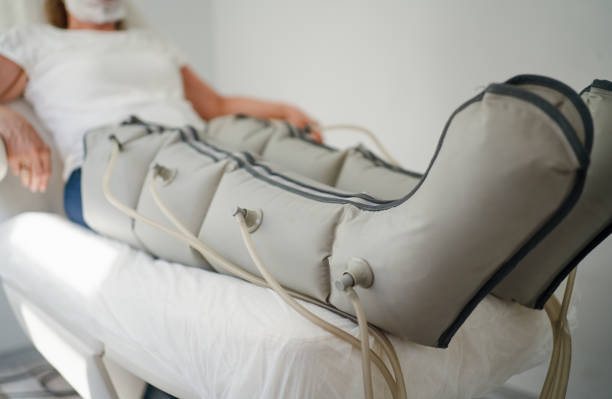In the realm of physical health and wellness, two emerging techniques are making significant strides: compression therapy and percussion therapy. Both methods have gained popularity due to their effectiveness in enhancing recovery, reducing pain, and improving overall physical performance. This article delves into the details of these therapies, exploring their mechanisms, benefits, and applications.
Understanding Compression Therapy
Compression therapy involves the application of controlled pressure to improve blood flow, reduce swelling, and alleviate pain. It is commonly used in the treatment of various conditions, including venous disorders, lymphedema, and sports injuries. This therapy can be administered through various devices such as compression garments, bandages, and pneumatic compression pumps.
How Compression Therapy Works
The principle behind compression therapy is relatively simple yet highly effective. By applying external pressure to the limbs, the therapy promotes the venous return of blood to the heart, which enhances circulation. This process helps in reducing the pooling of blood in the veins, which is often the cause of swelling and discomfort. Furthermore, improved blood flow ensures that oxygen and nutrients are efficiently delivered to the tissues, facilitating faster recovery and healing.
Benefits of Compression Therapy
Compression therapy offers a plethora of benefits, making it a staple in both medical and athletic settings. Some of the notable advantages include:
- Reduced Swelling and Edema: By preventing fluid accumulation in tissues, compression therapy effectively reduces swelling.
- Pain Relief: Enhanced circulation and reduced swelling contribute to significant pain relief.
- Improved Athletic Performance: Athletes use compression garments to support muscle function and enhance recovery post-exercise.
- Prevention of Deep Vein Thrombosis (DVT): Compression therapy is crucial for patients at risk of DVT, as it helps prevent blood clots.
Exploring Percussion Therapy
On the other hand, percussion therapy involves the use of rapid, repetitive movements to stimulate muscle tissues. This method is often implemented using devices like massage guns or percussion massagers. The primary goal of percussion therapy is to relieve muscle tension, enhance flexibility, and accelerate recovery.

Mechanism of Percussion Therapy
Percussion therapy operates through mechanical vibrations delivered deep into the muscle tissues. These vibrations improve blood flow, break down adhesions and scar tissue, and reduce muscle tightness. The deep tissue stimulation provided by percussion devices can reach muscles that are otherwise difficult to target with traditional massage techniques.
Benefits of Percussion Therapy
The advantages of percussion therapy are numerous, particularly for individuals experiencing muscle soreness and stiffness. Key benefits include:
- Enhanced Muscle Recovery: The deep tissue stimulation accelerates the removal of lactic acid, reducing muscle soreness.
- Increased Range of Motion: By relieving muscle tension, percussion therapy improves flexibility and range of motion.
- Pain Reduction: The therapy’s ability to break down scar tissue and adhesions helps in alleviating chronic pain.
- Improved Circulation: Similar to compression therapy, percussion therapy enhances blood flow, which is essential for muscle health and recovery.
Applications in Sports and Rehabilitation
Both compression therapy and percussion therapy have found extensive applications in sports and rehabilitation. Athletes, in particular, have integrated these therapies into their routines to optimize performance and recovery.
Compression Therapy in Sports
Athletes often wear compression garments during and after their training sessions. These garments not only support muscle function but also aid in quicker recovery by reducing muscle oscillation and promoting efficient blood flow. Post-exercise, compression therapy helps in minimizing muscle soreness and swelling, allowing athletes to train consistently without prolonged downtime.
Percussion Therapy in Rehabilitation
Percussion therapy is a popular choice among physical therapists and chiropractors. It is used to treat a variety of conditions, from muscle strains to chronic pain disorders. The therapy’s ability to provide deep muscle stimulation makes it effective in breaking down scar tissue and promoting muscle relaxation. This is particularly beneficial for patients recovering from surgeries or injuries, as it accelerates the rehabilitation process.
Combining Therapies for Optimal Results
While compression therapy and percussion therapy are highly effective on their own, combining the two can lead to even better outcomes. For instance, athletes can use percussion therapy before a workout to warm up muscles and enhance flexibility, followed by compression therapy post-exercise to reduce swelling and speed up recovery. Similarly, patients in rehabilitation programs can benefit from the combined effects of improved circulation and deep tissue stimulation.
Conclusion
In conclusion, compression therapy and percussion therapy are transformative techniques in the field of physical health and wellness. Compression therapy excels in enhancing circulation, reducing swelling, and preventing conditions like DVT. Percussion therapy, with its deep tissue stimulation, is highly effective in relieving muscle tension, accelerating recovery, and improving flexibility. Both therapies, whether used independently or in combination, offer substantial benefits that cater to a wide range of individuals, from athletes to patients undergoing rehabilitation. As these therapies continue to evolve, their applications and efficacy are likely to expand, offering even greater potential for improving physical health and performance.






